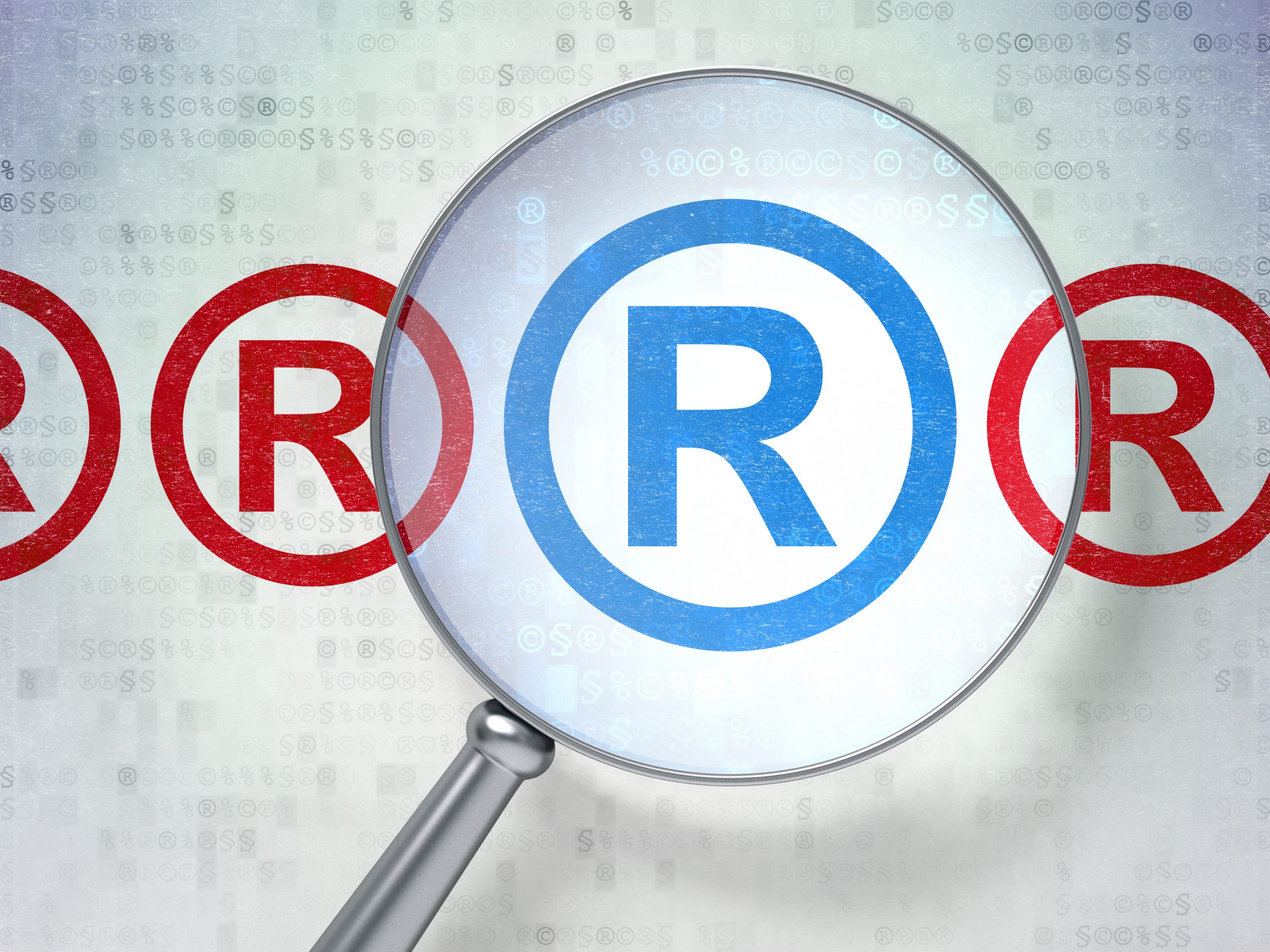“After all of Prince’s efforts to make it look otherwise, the word mark was still determined to be nothing more than a letter of the alphabet.”
 A single alphabet letter mark may face a bigger challenge to trademark registration in some jurisdictions than others.
A single alphabet letter mark may face a bigger challenge to trademark registration in some jurisdictions than others.
Take the example of Prince Sports International Company Ltd.’s stylized letter  .
.
The Korean Trademark Act prevents registration of “a trademark that consists solely of a simple and common mark” under Article 33(1)(6). Prince Sports International Company Ltd., a Hong Kong-based company that manufactures sports goods, sought to register  as its trademark for jewelry, computers, online shopping mall businesses, etc. in Korea. It had already registered the same mark in the United States, Australia, and China, among other countries. In the United States, it is registered as Prince Sports, Inc.’s stylized word mark for tennis rackets. However, the Korean IP Office (KIPO) examiner rejected the application under the Korean Trademark Act, Article 33(1)(6)(a trademark that consists solely of a simple and common mark may not be registered) and Article 33(1) (7)(nondistinctive trademarks that do not serve as a source identifier for other reasons are also unregistrable). On appeal, the board sided with the examiner and the plaintiff filed the suit to revoke the administrative board decision in the Patent Court of Korea. The First Division of the Patent Court of Korea (Presiding Judge Jejeong Lee, Judge Kwangnam Kim, Judge Hee Young Jeong) held that the mark may not be registered.
as its trademark for jewelry, computers, online shopping mall businesses, etc. in Korea. It had already registered the same mark in the United States, Australia, and China, among other countries. In the United States, it is registered as Prince Sports, Inc.’s stylized word mark for tennis rackets. However, the Korean IP Office (KIPO) examiner rejected the application under the Korean Trademark Act, Article 33(1)(6)(a trademark that consists solely of a simple and common mark may not be registered) and Article 33(1) (7)(nondistinctive trademarks that do not serve as a source identifier for other reasons are also unregistrable). On appeal, the board sided with the examiner and the plaintiff filed the suit to revoke the administrative board decision in the Patent Court of Korea. The First Division of the Patent Court of Korea (Presiding Judge Jejeong Lee, Judge Kwangnam Kim, Judge Hee Young Jeong) held that the mark may not be registered.
The Simple and Common Standard
The Supreme Court’s interpretation of Article 33(1)(6) is that whether a mark is simple and common depends on the specific facts of the case, taking into account trade practice and whether excluding others from use of the mark would be appropriate (Supreme Court Decision 2003Hu2942 Decided November 26, 2004). The Supreme Court has also held that a mark that is a stylized version of a common figure or letter may survive the “simple and common” standard only when the mark is designed to a degree that it would be viewed as something more than the original unstylized figure and would draw special attention of ordinary consumers or traders (Supreme Court Decision 2006Hu3632 Decided March 16, 2007). In addition to the above Trademark Act provision, KIPO has issued guidelines stating that a letter mark consisting of two or less foreign letters is deemed simple and common in principle. Such a mark needs additional elements to survive, like design, color, or other features that will make the mark distinctive as a whole.
 Is Just a P, and Nothing More
Is Just a P, and Nothing More
In the above-cited 2003Hu2942 decision, the mark ![]() survived the simple-and-common test; while “R,” “M,” and “-” were all deemed simple and common by themselves, the way they were combined and arranged delivered a new impression. On the contrary, in the 2006Hu3632 decision, the mark consisting solely of
survived the simple-and-common test; while “R,” “M,” and “-” were all deemed simple and common by themselves, the way they were combined and arranged delivered a new impression. On the contrary, in the 2006Hu3632 decision, the mark consisting solely of ![]() was held as simple and common. The Supreme Court stated that, while the diamond shape slightly differed from the typical form with it being horizontally stretched, it was not stylized enough to deliver a new impression to ordinary consumers or traders.
was held as simple and common. The Supreme Court stated that, while the diamond shape slightly differed from the typical form with it being horizontally stretched, it was not stylized enough to deliver a new impression to ordinary consumers or traders.
 was held to be more like
was held to be more like ![]() than
than ![]() .
.
The plaintiff came up with a variety of ideas to persuade the court that its mark was not a simple alphabet letter “P”. According to Prince, the mark is a simplified shape of a tennis racket, household broom, or Chinese kitchen knife: simple, perhaps, but not common. Since Trademark Act Article 33(1)(6) stipulates against a simple AND common mark, a simple but uncommon mark should be granted. The court did not budge. After all of Prince’s efforts to make it look otherwise, the mark was still determined to be nothing more than a letter of the alphabet. The mark’s slightly unique design—with the counter (the empty middle space) having the shape of a rounded rectangle instead of the more common circle or semicircle—still fell short of a newly created figure that would generate special attention from ordinary consumers or traders, said the court. Failing that argument, the plaintiff claimed that the mark is different than the letter “P” in popular and easily accessible fonts in Microsoft Word, PowerPoint, or Hangul (a word processing software installed in nearly all office computers in Korea, named after the Korean alphabet Hangul). Dismissing this argument as well, the court affirmed the board decision. The Patent Court’s decision was confirmed as final without an appeal to the Supreme Court.
Registering Letters of the Alphabet
This does not mean that a mark consisting of a single alphabet letter can never be registered in Korea. It seems to be the level of stylization required for registration that differs between Korea and, for example, the United States., due to the rule against simple and common marks under the Korean Trademark Act. A mark is registrable as long as it is sufficiently stylized. Take  for A. Testoni’s t-shirts. The Supreme Court held that the mark was registrable because the way the letter “t” was designed made it look like the anchor of a ship rather than merely a common mark consisting of a single alphabet letter (Supreme Court Decision 92Hu2267 Decided July 27, 1993).
for A. Testoni’s t-shirts. The Supreme Court held that the mark was registrable because the way the letter “t” was designed made it look like the anchor of a ship rather than merely a common mark consisting of a single alphabet letter (Supreme Court Decision 92Hu2267 Decided July 27, 1993).
Another option is to pursue use-based distinctiveness if the elements are met. Korean Trademark Act Article 33(2) provides that a trademark may be registered on the ground of distinctiveness acquired based on use since before filing, depending on the nature of its original nondistinctiveness, provided that the registration is limited to the goods that the applicant has used the mark thereon. In this case, the defendant (KIPO commissioner) argued that Prince’s competitor in the sports goods market, Wilson, had registered ![]() for use-based distinctiveness, and therefore it should not count in favor of the mark at issue.
for use-based distinctiveness, and therefore it should not count in favor of the mark at issue.
Another easy answer may be simply to add other elements, as hinted above. Prince Sports Group, Inc. has registered and maintained  for tennis rackets since the 1980s.
for tennis rackets since the 1980s.
Judge Kwangnam Kim, Director of International IP Law Research Center (IIPRC) of the Patent Court of Korea, provided feedback and guidance for this article.
Image Source: Deposit Photos
Author: maxkabakov
Image ID: 22207335

![[IPWatchdog Logo]](https://ipwatchdog.com/wp-content/themes/IPWatchdog%20-%202023/assets/images/temp/logo-small@2x.png)

![[Advertisement]](https://ipwatchdog.com/wp-content/uploads/2024/04/UnitedLex-May-2-2024-sidebar-700x500-1.jpg)
![[Advertisement]](https://ipwatchdog.com/wp-content/uploads/2024/04/Artificial-Intelligence-2024-REPLAY-sidebar-700x500-corrected.jpg)
![[Advertisement]](https://ipwatchdog.com/wp-content/uploads/2024/04/Patent-Litigation-Masters-2024-sidebar-700x500-1.jpg)

![[Advertisement]](https://ipwatchdog.com/wp-content/uploads/2021/12/WEBINAR-336-x-280-px.png)
![[Advertisement]](https://ipwatchdog.com/wp-content/uploads/2021/12/2021-Patent-Practice-on-Demand-recorded-Feb-2021-336-x-280.jpg)
![[Advertisement]](https://ipwatchdog.com/wp-content/uploads/2021/12/Ad-4-The-Invent-Patent-System™.png)






Join the Discussion
No comments yet.